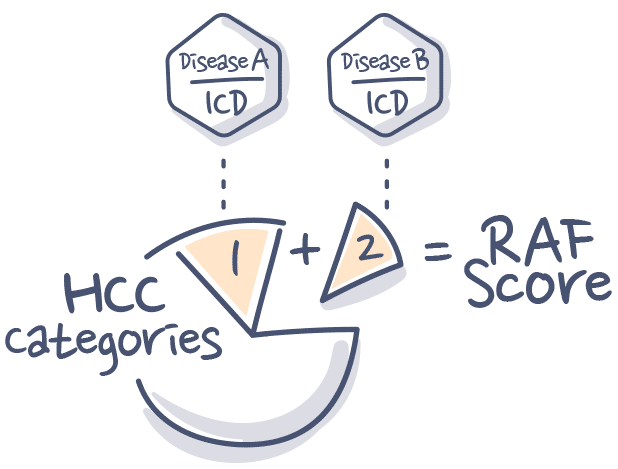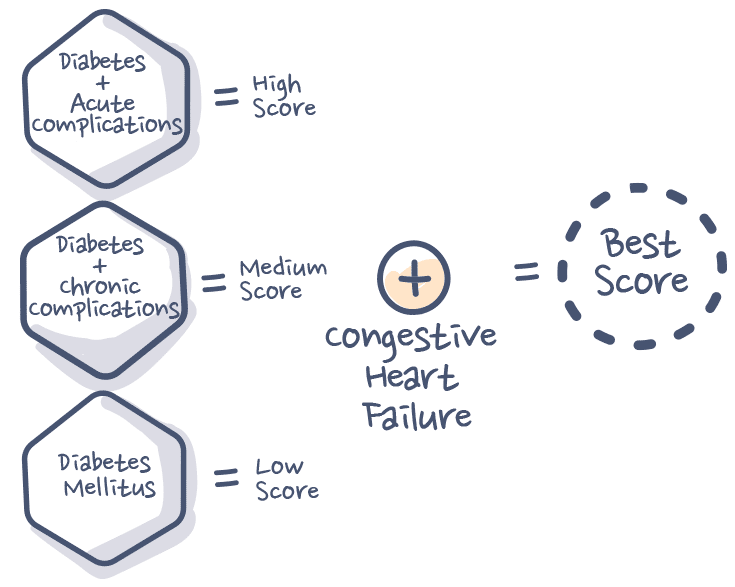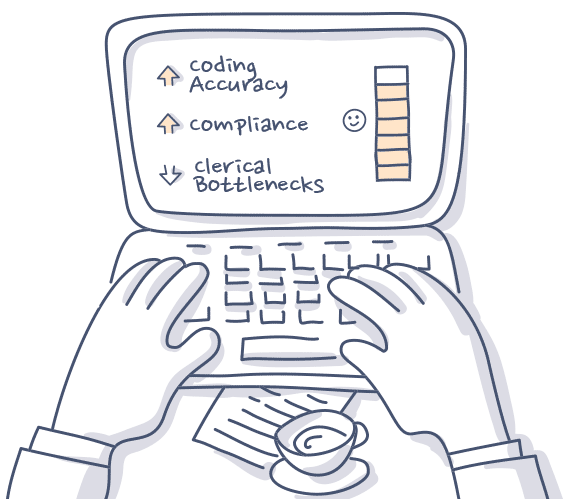Risk Adjustment Factor: RAF Score
What is Medicare risk adjustment?
Medicare risk adjustment is a process that Medicare uses to pay health plans. Medicare pays health plans based on the number of Medicare beneficiaries enrolled in the plan, and the risk scores of those beneficiaries. Medicare risk scores are calculated using a formula that takes into account many different factors, including age, sex, race, health status, and use of Medicare services.
Medicare risk adjustment is designed to ensure that Medicare pays health plans fairly, and that plans are not unfairly penalized for enrolling sicker beneficiaries. Medicare risk adjustment is also intended to encourage health plans to enroll accurately represented beneficiaries of all types, including high risk enrollees with chronic medical conditions and those who are likely to need more expensive care.
There are many different models and financial incentives for medical risk adjustment within the health and human services system. The Centers for Medicare & Medicaid Service (CMS) risk adjustment model uses the Hierarchical Condition Category (HCC) method to calculate risk scores for Medicare Advantage beneficiaries. This method puts related encounter data like medical diagnoses into groupings based on resource use. Higher category risk scores represent higher anticipated healthcare costs for Medicare Advantage health plans. For example, chronic medical conditions like a diabetes diagnoses, including complications, has a higher risk score and in turn greater anticipated Medicare Advantage risk and healthcare costs than diabetes without complications.
HCCs are a grouping of clinically related diagnosis codes with similar associated cost to the healthcare system. Only those ICD codes that map to an HCC category are used in the risk adjustment processing system. Not all encounter data like diagnosis codes will “risk adjust,” or map to an HCC in the Medicare risk adjustment model. Some health risk assessments may not be predictive of ongoing expenses, but severe acute diseases and injuries or chronic conditions such as diabetes, heart failure, and chronic obstructive pulmonary disease may pose a continuing financial burden to the healthcare system.
How does it work?
All risk adjustment models rely on comprehensive healthcare analytics, encounter data and evidence-based reporting of patient care. CMS Federal Government policy requires that a qualified healthcare provider describe all chronic conditions and severe diagnoses for every patient, every year, to establish a health profile. Documentation in health risk assessments must indicate the provider’s health care services plan for patient help or Management, Evaluation, Assessment or Treatment (MEAT) of the condition. Using HCC risk adjustment coding and Medicare risk adjustment software this encounter data is then used to predict health costs for the subsequent contract year for the health plan. Inaccurate or non-specific diagnoses can impact health care services, outcomes and reimbursement payment to the health plan for ongoing care of that patient.
What is RAF / What is a RAF Score ?
RAF medical abbreviation stands for risk adjustment factor. A beneficiary’s RAF or RAF score calculation is based on the beneficiary's clinical conditions and demographic factors such as Medicaid and disability status, gender, age, and whether the beneficiary lives in the community or in an institution, like a skilled nursing facility.
Higher risk scores or RAF medical abbreviation “RAF score”, represent patient medical records with a greater than average disease burden. A RAF score meaning a lower calculation typically represents a healthier population view, but may also falsely indicate a healthy population when there is poor chart documentation or incomplete Medicare risk adjustment coding.
"RAF scores” are chosen for beneficiary medical records according to the patient’s demographics, clinical conditions, and other factors. Risk adjustment ensures the beneficiary’s Medicare risk score or RAF score depicts the patient’s predicted health costs compared to those of an average beneficiary. RAF is a relative measure of the predicted costs to meet the needs of the beneficiary’s health conditions.
Health plans collect payments for covered members from CMS. A risk adjustment factor system is used to adjust plan payments to ensure fair payment to the health plan for providing healthcare services and benefits for a population of patients, sometimes know as population health management. The payments are determined by a complex formula that applies the Medicare risk adjustment factor terms to an average payment based on location. Other factors play a role in the risk adjustment payment calculation such as actuarial adjustments related to how the HCC model compares with the fee-for-service population and of course the patient’s health status. RAF Medicare scores increase based on the condition count (how many HCC conditions the patient has). There are certain disease interaction algorithms that may increase the risk adjustment score or risk score. There is also disease hierarchy logic that prevents inflated risk adjustment scores - example: the RAF healthcare score will not increase if you diagnose “breast cancer” and “metastatic breast cancer” in the same patient. The hierarchy logic is based on the RAF healthcare score for the more severe illness - metastatic breast cancer “supersedes” breast cancer without metastasis. In this example the Medicare RAF score or risk score of the patient related to breast cancer disease is calculated exclusively on the RAF score for metastatic breast cancer.
Medicare and Medicaid risk adjustment is used to modify capitated payments for beneficiaries enrolled in health plans. CMS Federal Government policy requires that a qualified healthcare provider identify all conditions related to a patients health status that may fall within an HCC at least one time, each and every calendar year. Many providers feel this requirement is a time consuming clerical burden on resources! It is challenging to have to look through the complete medical record each year to document all HCC related diagnosis codes. To reduce the burden of risk adjustment on physicians and coders, healthcare organizations are beginning to adopt CMS risk adjustment software to help search and capture all the appropriate conditions of each patient in their Medicare Advantage population. Using computer assisted coding like Medicare risk adjustment software that can synthesize the encounter data and quickly associate evidence for HCC related disease helps CMS match insurance payment accurately to the resource requirements of a Medicare Advantage population.
Risk adjustment optimization
Risk adjustment optimization is a process used to manage risk in healthcare. It helps identify high risk enrollees or sicker patients at higher risk for complications or poor health outcomes, and then creates a plan to address those health status risks. Successful risk adjustment optimization involves using encounter data to create models that predict how likely a patient is to experience a certain health outcome. This information can then be used to develop targeted interventions for high-risk patients.
Risk adjustment optimization is an important tool for healthcare providers, as it can help them reduce the overall cost of care and improve patient outcomes. In addition, risk adjustment optimization can help providers meet quality measures and avoid penalties.
There are several different types of data that can be used for risk adjustment or risk score optimization, including claims data, clinical data, and demographic data. Claims data includes information on health status like diagnoses, procedures, and medications. Clinical data includes information from laboratory tests, vital signs, and medical records. Demographic data includes information on age, gender, race, and zip code.
Different types of data can be combined to create more accurate risk coding models. For example, claims data and clinical data can be used together to create a model that predicts the likelihood of a patient being readmitted to the hospital.
Successful risk adjustment or risk score optimization is a complex process, but it is an important tool for managing any risk adjustment program in healthcare. By using encounter data in the medical record and risk adjustment software to identify high-risk patients, providers can develop targeted interventions that can improve patient outcomes and reduce the overall cost of care.
Types of risk adjustment
There are two main types of Medicare risk adjustment coding practices: prospective risk adjustment and retrospective risk adjustment.
Prospective risk adjustment is used to calculate Medicare payments to health plans before beneficiaries receive any face to face encounters. Medicare uses a formula to calculate a risk score for each beneficiary, based on the beneficiary's demographics and health status in their medical record. This risk score is then used to adjust the Medicare payment that the health plan will receive for that beneficiary.
Retrospective risk adjustment is used to calculate Medicare payments to health plans after beneficiaries have received care. Medicare uses claims data to calculate a risk score for each beneficiary, based on the care that the beneficiary received. This risk score is then used to adjust the Medicare payment that the health plan will receive for that beneficiary.
Medicare risk adjustment coding practices are important tools that ensure Medicare pays health plans fairly. Medicare risk adjustment is also an important way to encourage health plans to enroll beneficiaries of all types, including those with chronic illnesses and those who are likely to need more expensive care.
Risk adjustment tools
Since HCC coding is not intuitive, but accurate HCC coding is necessary to receive fair compensation, the integration of risk adjustment software with electronic health record systems can be extremely effective for Medicare Advantage risk adjustment optimization. Some specialized medical risk adjustment software platforms can collect available patient data, and using artificial intelligence (AI) and medical algorithms, detect HCC related diseases from patient charts and suggest ICD codes that optimize RAF Medicare payments.
With increasing numbers of at risk populations with chronic medical conditions, healthcare organizations need to speed pre-encounter preparation and improve coding productivity standards before a claim is sent. Medicare Advantage risk adjustment software with clinical decision support at the point of care during annual wellness visits makes it easier to close HCC and HEDIS gaps, thereby reducing the clinical documentation workload on office staff and increasing financial incentives.
Can your team review every encounter within 24 hours of the visit for accurate HCC coding? Do you need to increase the number of chart reviews per hour? Do your physicians get decision support related to patient disease burden within their electronic medical record systems at the point of care? If not, then consider state of the art Medicare risk adjustment software as part of your risk adjustment program strategy.
When it comes to choosing Medicare Advantage risk adjustment software, it's important to find a solution that fits your specific needs. Not all risk adjustment software programs are created equal, and each one has its own set of features and benefits.
Leveraging AI in Medicare risk adjustment
Leveraging AI in Medicare risk adjustment represents a transformative approach to improving the accuracy and efficiency of healthcare financing systems. AI, with its advanced data processing capabilities and predictive analytics, can analyze vast amounts of medical data—including diagnoses, medical claims, and patient histories—to more precisely assess patient RAF scores. This enhanced precision in Medicare risk adjustment helps to ensure that insurers are adequately compensated for the risk they bear, preventing underfunding for those with sicker enrollees and avoiding overpayments for healthier ones.
The implementation of AI technologies in this domain also facilitates a more dynamic and real-time analysis of risk adjustment factors. Traditional methods often rely on historical data that may not accurately reflect current patient conditions, leading to discrepancies in funding allocations. AI models can integrate and analyze real-time data streams, such as new medical diagnoses or changes in health status, enabling adjustments to risk scores as patient health evolves. This timeliness not only improves the fairness and responsiveness of funding models but also allows healthcare providers to better tailor their services to individual patient needs, potentially improving outcomes and reducing costs.
Moreover, AI can help mitigate issues of fraud and data inaccuracies which are significant concerns in manual risk adjustment processes. Through sophisticated medical algorithms and machine learning techniques, AI systems can identify anomalies and patterns that may indicate fraudulent claims or errors in data entry. By improving the integrity of the data used in risk adjustment calculations, AI not only enhances the reliability of the funding model but also contributes to a more equitable distribution of resources across the Medicare system. As such, embracing AI in Medicare risk adjustment is not just about technological advancement but also about promoting transparency, efficiency, and fairness in healthcare financing.
Benefits of risk adjustment software
Medicare risk adjustment software can be a powerful tool for healthcare organizations to use in order to optimize their Medicare reimbursements and reduce administrative expenses. It helps to identify coding opportunities that would otherwise go undetected, as well as accurately calculate payments from insurers based on established risk scores. With risk adjustment software, healthcare organizations are better equipped to improve accuracy of diagnoses and ensure appropriate reimbursement levels for the care they provide. Additionally, with the help of analytics-driven insights, healthcare organizations can better understand patient populations and proactively manage risks associated with treating them. This increased awareness allows healthcare organizations to provide more targeted care services that are tailored to the needs of individual patients, ultimately leading to improved health outcomes for everyone involved. By utilizing medicare risk adjustment software, healthcare practitioners can maximize their reimbursements and ensure that they are in compliance with Medicare regulations. These tools provide a valuable resource for any healthcare organization looking to streamline their risk adjustment processes and maximize the value of their Medicare risk contracts.
Why healthcare needs risk adjustment software
Healthcare plans, especially Medicare Advantage Organizations (MAOs), are increasingly challenged by intricate regulations and rigorous audits. CMS predicts that audits specifically targeting Risk Adjustment Data Validation (RADV) could lead to potential recoveries totaling approximately $4.7 billion by 2032. These audits verify the precision of risk scores given to Medicare Advantage beneficiaries, scores which are crucial for determining the rates of reimbursement.
Healthcare organizations need Medicare risk adjustment software to ensure that their healthcare services are covered adequately by Medicare. Risk adjustment software optimizes the coding of healthcare services, allowing for accurate reimbursement from CMS. Without accurate coding and optimization, healthcare organizations may not receive full reimbursement for their services, thereby reducing their ability to provide necessary care. Medicare risk adjustment software helps to streamline the process of coding and submitting claims to CMS, allowing healthcare organizations to increase revenue and improve patient care. Furthermore, it ensures that all eligible patients receive appropriate coverage for their medical needs. Investing in medicare risk adjustment software is essential for providing quality care while also receiving adequate reimbursement from CMS.
By using risk adjustment software, healthcare organizations are able to identify potential coding errors or inconsistencies that could lead to under-reimbursement. The use of risk adjustment software also helps to minimize the amount of manual labor required by healthcare professionals while still ensuring accurate coding and optimization. This can lead to increased efficiency in the reimbursement process, allowing organizations to manage their resources more effectively and increase overall patient satisfaction. Additionally, risk adjustment software can be used for predictive analytics which can help healthcare organizations anticipate potential issues before they arise and better plan for future changes in reimbursements. Medicare risk adjustment software is a valuable tool that allows healthcare organizations to optimize their reimbursement from CMS while improving patient care.
Consider if your current software has:
Artificial Intelligence with natural language processing (NLP) that reads unstructured data (PDFs) of hospital discharge summaries, PCP notes, consults, lab, and radiology reports.
Smart Recapture that filters for codes used in the previous year that do not have the proper support documentation in the current year.
EHR Integration that adapts to your current workflow and presents risk adjustment suspects conveniently on your EHR screen at the point of care along with HCC coding recommendations.
InstaVu® hyperlinks to original documentation, allowing you to click on a suspect and immediately display the exact page of the original documentation with the disease highlighted on the screen.
V24 to V28 Optimizer® that facilitates HCC detection using both the V24 and V28 models, ensuring a smooth transition between the two frameworks.
Please let us know if you or your team would be interested in a short presentation of our solution. Among our clients are some of the largest health systems and risk-bearing provider organizations in the country. We would welcome the opportunity to share the value we can bring to your organization.







